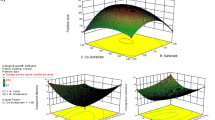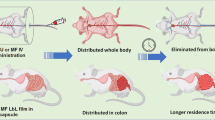Abstract
The employment of site-specific administration in colon is a promising technique to improve efficacy and reduce systemic side effects of anticancer medications used in colorectal cancer. However, the physiology of the gastrointestinal tract and colonic environment limit the efficient delivery of orally administered anticancer drugs to the colon. These prerequisites can be fulfilled by a release modulated colon targeted drug delivery system (CTDDS) based on pH-dependent chronotherapeutic bilayer tablet of sorafenib tosylate (ST). Quality by design (QbD) was used to examine the risk assessment. The Box–Behnken design was used to optimize the core uncoated bilayer tablet, whereas the 22 factorial design was used to optimize the coating process. The amount of croscarmellose sodium, Eudragit® RLPO, and tablet hardness all had a significant impact on disintegration time and drug release, according to the results of the core uncoated bilayer optimization. The amount of Eudragit® S 100 and PEG 400 in the final coated tablet had a considerable impact on drug release. The optimized formulation demonstrated 5-h lag time, a peculiar feature of CTDDS. The pharmacokinetic studies of coated tablet in rabbits showed lower Cmax (4.45 ± 0.40 µg/mL) and AUC (148.52 ± 3.96 h µg/mL), whereas Tmax was substantially delayed (8.0 ± 0.57 h) compared to core uncoated tablet. The tablet remained intact until it reached the colon (> 4 h), according to the in vivo roentgenography studies. The present study revealed that a QbD approach can be useful to develop a rugged and scalable CTDDS.
Graphical Abstract









Similar content being viewed by others
Data Availability
On reasonable request, the corresponding author will provide the datasets used and/or analysed during the current work.
References
Narola A, Spar MD RS. Gastrointestinal disease in men. Integrativ. Spar MD MG, editor. New York: Oxford University press; 2014.
Crosta P. Everything you need to know about colon cancer [Internet]. 2019. Available from: https://www.medicalnewstoday.com/articles/150496. Acccessed 20 Jan 2022.
Institute NC. Drugs Approved for Colon and Rectal Cancer [Internet]. 2020. Available from: https://www.cancer.gov/about-cancer/treatment/drugs/colorectal. Acccessed 20 Jan 2022
Viscido A, Capannolo A, Latella G, Caprilli R, Frieri G. Nanotechnology in the treatment of inflammatory bowel diseases. J Crohn’s Colitis [Internet]. European Crohn’s and Colitis Organisation; 2014;8:903–18. Available from: https://doi.org/10.1016/j.crohns.2014.02.024
Utreja P, Jain SK, Tiwary A. Novel drug delivery systems for sustained and targeted delivery of anti-cancer drugs: current status and future prospects. Curr Drug Deliv. 2010;7:152–61.
Amidon S, Brown JE, Dave VS. Colon-targeted oral drug delivery systems: design trends and approaches. AAPS PharmSciTech. 2015;16:731–41.
Agüero L, Zaldivar-Silva D, Peña L, Dias M. Alginate microparticles as oral colon drug delivery device: a review. Carbohydr Polym [Internet]. Elsevier Ltd.; 2017;168:32–43. Available from: https://doi.org/10.1016/j.carbpol.2017.03.033
Zhang F. Melt-extruded Eudragit® FS-based granules for colonic drug delivery. AAPS PharmSciTech. 2016;17:56–67.
T Bussemer, I Otto RB. Pulsatile drug-delivery systems. Crit Rev Ther Drug Carr Syst. 2001;18:433–58.
Jain D, Bar-Shalom D. Alginate drug delivery systems: application in context of pharmaceutical and biomedical research. Drug Dev Ind Pharm. 2014;40:1576–84.
Jain A, Gulbake A, Shilpi S, Jain A, Hurkat P, Jain SK. A new horizon in modifications of chitosan: Syntheses and applications. Crit Rev Ther Drug Carrier Syst. 2013;30:91–181.
Yang L. Biorelevant dissolution testing of colon-specific delivery systems activated by colonic microflora. J Control Release. 2008;125:77–86.
Gulbake A, Jain A, Jain A, Jain A, Jain SK. Insight to drug delivery aspects for colorectal cancer. World J Gastroenterol. 2016;22:582–99.
Focaccetti C, Bruno A, Magnani E, Bartolini D, Principi E, Dallaglio K, et al. Effects of 5-fluorouracil on morphology, cell cycle, proliferation, apoptosis, autophagy and ros production in endothelial cells and cardiomyocytes. PLoS ONE. 2015;10:1–25.
Chabner BA, Amrein PC, Druker B, Michaelson MD, Mitsiades CS GP. Goodman Gilman’s The Pharmacological basis of therapeutics. Mc Graw Hill Companies Inc; 2006.
Chavez M, Nagel KM KA. Gibaldi’s drug delivery systems in pharmaceutical care. American Society of Health system Pharmacists; 2007.
Hashizume H, Baluk P, Morikawa S, McLean JW, Thurston G, Roberge S, et al. Openings between defective endothelial cells explain tumor vessel leakiness. Am J Pathol [Internet]. American Society for Investigative Pathology; 2000;156:1363–80. Available from: https://doi.org/10.1016/S0002-9440(10)65006-7
Handali S, Moghimipour E, Rezaei M, Kouchak M, Ramezani Z, Dorkoosh FA. In vitro and in vivo evaluation of coated capsules for colonic delivery. J Drug Deliv Sci Technol [Internet]. Elsevier B.V.; 2018;47:492–8. Available from: https://doi.org/10.1016/j.jddst.2018.07.027
Subudhi MB, Jain A, Jain A, Hurkat P, Shilpi S, Gulbake A, et al. Eudragit S100 coated citrus pectin nanoparticles for colon targeting of 5-fluorouracil. Materials (Basel). 2015;8:832–49.
Kumari A, Jain A, Hurkat P, Tiwari A, Jain SK. Eudragit S100 coated microsponges for colon targeting of prednisolone. Drug Dev Ind Pharm [Internet]. Taylor & Francis; 2018;44:902–13. Available from: https://doi.org/10.1080/03639045.2017.1420079
Cheng H, Huang S, Huang G. Design and application of oral colon administration system. J Enzyme Inhib Med Chem [Internet]. Taylor & Francis; 2019;34:1590–6. Available from: https://doi.org/10.1080/14756366.2019.1655406
Bank D. Sorafenib tosylate [Internet]. Available from: https://go.drugbank.com/salts/DBSALT000165. Acccessed 20 Jan 2022.
Sahastrabudhe H, Kenjale P, Pokharkar V. Development of sustained release oseltamivir phosphate dry powder inhaler: in-vitro characterization and in-vivo toxicological studies. Curr Drug Deliv. 2020;17:703–10.
Kenjale PP, Joshi MA, Khatavkar UN, Dhapte VV, Pokharkar VB. Paroxetine hydrochloride push-pull osmotic pump tablets: designing an innovative, scalable push-pull osmotic drug delivery system using QbD approach. Drug Deliv Lett. 2019;10:104–16.
Sangshetti JN, Deshpande M, Arote R, Zaheer Z, Shinde DB. Quality by design approach : Regulatory need. Arab J Chem. King Saud University; 2014; https://doi.org/10.1016/j.arabjc.2014.01.025
United States Food and Drug Administration. Quality by design for ANDAs : an example for modified-release dosage forms. 2011;1–161.
Iurian S, Turdean L, Tomuta I. Risk assessment and experimental design in the development of a prolonged release drug delivery system with paliperidone. Drug Des Devel Ther. 2017;11:733–46.
Parmar C, Parikh K, Mundada P, Bhavsar D, Sawant K. Formulation and optimization of enteric coated bilayer tablets of mesalamine by RSM: in vitro – in vivo investigations and roentogenographic study. J Drug Deliv Sci Technol [Internet]. Elsevier B.V.; 2018;44:388–98. Available from: https://doi.org/10.1016/j.jddst.2018.01.008
Patel MM, Amin AF. Formulation and development of release modulated colon targeted system of meloxicam for potential application in the prophylaxis of colorectal cancer. Drug Deliv. 2011;18:281–93.
Truong DH, Tran TH, Ramasamy T, Choi JY, Choi HG, Yong CS, et al. Preparation and characterization of solid dispersion using a novel amphiphilic copolymer to enhance dissolution and oral bioavailability of sorafenib. Powder Technol [Internet]. Elsevier B.V.; 2015;283:260–5. Available from: https://doi.org/10.1016/j.powtec.2015.04.044
Khairnar G, Naik J, Mokale V. A statistical study on the development of micro particulate sustained drug delivery system for Losartan potassium by 3 2 factorial design approach. Bull Fac Pharmacy, Cairo Univ [Internet]. Faculty of Pharmacy, Cairo University; 2017;55:19–29. Available from: https://doi.org/10.1016/j.bfopcu.2016.10.001
Nayak AK, Pal D, Pradhan J, Hasnain MS. Fenugreek seed mucilage-alginate mucoadhesive beads of metformin HCl: design, optimization and evaluation. Int J Biol Macromol [Internet]. Elsevier B.V.; 2013;54:144–54. Available from: https://doi.org/10.1016/j.ijbiomac.2012.12.008
Patel A, Dodiya H, Shelate P, Shastri D, Dave D. Design, characterization, and optimization of controlled drug delivery system containing antibiotic drugs. J Drug Deliv. 2016;1–15.
Lee AR, Kwon SY, Choi DH, Park ES. Quality by Design (QbD) approach to optimize the formulation of a bilayer combination tablet (Telmiduo®) manufactured via high shear wet granulation. Int J Pharm Elsevier. 2017;534:144–58.
Mehta R, Chawla A, Sharma P, Pawar P. Formulation and in vitro evaluation of Eudragit S-100 coated naproxen matrix tablets for colon-targeted drug delivery system. J Adv Pharm Technol Res. 2013;4:31–41.
Rowe, Raymond;Shaesky, Paul;Quinn M. Handbook of Pharmaceutical Excipients. 6th ed. Pharmaceutical Press; 2009.
Dupoint. Why settle for super when you can have superior ? High-quality Ac-Di-Sol ® offers all the advantages of a superior disintegrant. 2020.
Evonik Industries. Eudragit® Setting benchmarks in oral solid dosage forms since 1954.
Pankaj N, Hitendra M, Pradum I, Rajput P. Development and in vitro evaluation of Eudragit RLPO based polymeric nanoparticles of Lansoprazole. Indian J Nov Drug Deliv. 2017;8:165–74.
Patra CN, Priya R, Swain S, Kumar Jena G, Panigrahi KC, Ghose D. Pharmaceutical significance of Eudragit: a review. Futur J Pharm Sci. Elsevier B.V.; 2017;3:33–45.
Parvatkar A. EUDRAGIT: A VERSATILE AND ROBUST PLATFORM Shilpa Bhilegaonkar and Aishwarya Parvatkar * Department of Pharmaceutics, P.E.S’s Rajaram and Tarabai Bandekar College of Pharmacy, Farmagudi Ponda - 403401, Goa, India. 2020;11:2626–35.
Schilling SU, Lirola HL, Shah NH, Waseem Malick A, McGinity JW. Influence of plasticizer type and level on the properties of Eudragit® S100 matrix pellets prepared by hot-melt extrusion. J Microencapsul. 2010;27:521–32.
Acknowledgements
The authors would like to thank Poona College of Pharmacy, Pune, for their help in providing facilities for this research. The authors would like to thank Cipla Pharmaceuticals Ltd. in India for supplying a free API sample.
Author information
Authors and Affiliations
Contributions
Prathmesh Kenjale: conceptualization, study design, research, data collection, interpretation of data, analysis methodology, investigation, visualization, writing—original draft. Varsha Pokharkar: conceptualization, methodology, project administration, supervision, writing—review and editing.
Corresponding author
Ethics declarations
Ethics Approval and Consent to Participate
The Committee for the Control and Supervision of Experiments on Animals authorized this animal research (CPCSEA). IAEC/PCP/PCT05/2019-2020 is the CPCSEA protocol number.
Human and Animal Rights
The studies on which this study is based did not use any persons. The animal research was carried out in complete compliance with institutional and CPCSEA rules.
Consent for Publication
This is not applicable.
Conflict of interest
The authors declare no competing interests.
Additional information
Publisher's Note
Springer Nature remains neutral with regard to jurisdictional claims in published maps and institutional affiliations.
Rights and permissions
About this article
Cite this article
Kenjale, P., Pokharkar, V. Risk Assessment and QbD-Based Optimization of Sorafenib Tosylate Colon Targeted Bilayer Tablet: In Vitro Characterization, In Vivo Pharmacokinetic, and In Vivo Roentgenography Studies. AAPS PharmSciTech 23, 184 (2022). https://doi.org/10.1208/s12249-022-02340-7
Received:
Accepted:
Published:
DOI: https://doi.org/10.1208/s12249-022-02340-7




